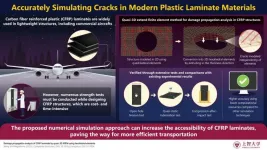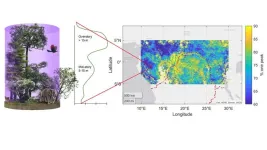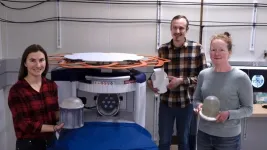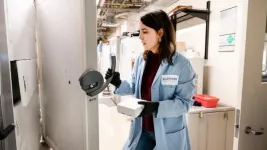(Press-News.org) LA JOLLA, CALIF. – July 17, 2023 – By identifying genes in patients and testing their effects in fruit flies, researchers from Sanford Burnham Prebys have found new genes that contribute to hypoplastic left heart syndrome (HLHS), a rare, life-threatening heart disease that occurs in infants. The findings, published in the journal eLife, bring scientists one step closer to unraveling the biology of this complex disease.
“Every case of HLHS is unique because there are many different things that can go wrong during the early development of the heart,” says senior author Rolf Bodmer, Ph.D., director of the Center for Genetic Disorders and Aging Research at Sanford Burnham Prebys. “If we’re able to uncover what drives this disease biologically, it may be possible to one day prevent the disease or reduce complications for people living with it.”
In babies with HLHS, the left side of the heart (left ventricle) is underdeveloped and unable to pump oxygenated blood to the rest of the body. The Centers for Disease Control and Prevention estimates that each year about 1,025 babies in the United States are born with HLHS, and it accounts for about 2–4% of all congenital heart defects. Though rare, HLHS is extremely dangerous—it is nearly always fatal without multiple open-heart surgeries.
Genetics is thought to be a major driver of HLHS, but the specific genes involved have remained a mystery. To look for genes that contribute to HLHS, the researchers sequenced the genomes of 183 people with HLHS and their parents, including a family in which the parents were genetically related to each other. Focusing on this family helped the researchers narrow their search to a few key genes.
“We inherit two different variants of each gene, one from each parent,” says Georg Vogler, Ph.D., a research assistant professor at Sanford Burnham Prebys and co-senior author of the study. “If both parents pass down a gene variant that can cause problems, then the effect of that gene variant is accentuated in the child. Because of this effect, this family gave us a unique opportunity to look for new genes that drive HLHS that may not be as apparent in other families.”
To test whether the genes they identified could be contributing to HLHS, the researchers performed genetic experiments on fruit fly hearts that are built with genes similar to those found in human hearts. They found that blocking the activity of these genes in flies interfered with their heart’s ability to contract, leading to significant heart defects.
“While more research will be needed to explore precisely how these genes result in heart defects, one hypothesis is that because certain gene variants make it harder for the heart to contract, blood can’t flow as easily to the left side of the heart, thus compromising its proper formation,” says Bodmer. “This could lead to the types of abnormalities seen in HLHS.”
While the researchers identified genes that can contribute to HLHS, they caution that it is unlikely we will find a single gene implicated in the disease in all cases.
“HLHS is driven by many genetic and environmental factors, but the more we can shed light on these factors, the better chance we have of finding new ways to prevent and treat the disease,” says Bodmer. “For example, it may be possible that increasing the activity of one of these genes could be enough to strengthen the heart and reduce the risk of heart complications in survivors.”
###
Additional authors on the study include Katja Birker, Shuchao Ge, James Marchant, Maria Azzurra Missinato, Sreehari Kalvakuri, Karen Ocorr, Alexandre R. Colas, Georg Vogler, Sanford Burnham Prebys; Natalie J. Kirkland, Adam J. Engler, Sanford Consortium for Regenerative Medicine; Jeanne L. Theis, Zachary C. Fogarty, Timothy J. Nelson and Timothy M. Olson, Mayo Clinic; and Paul Grossfield, UCSD School of Medicine.
The study was supported by grants from the National Institutes of Health (R01 HL054732, R01 HL153645, R01HL148827, R01 HL149992, R01 AG071464), a grant from the Wanek Foundation at the Mayo Clinic, and fellowships from the American Heart Association (18PRE33969593, 20POST35180048).
The study’s DOI is 10.7554/eLife.83385.
About Sanford Burnham Prebys
Sanford Burnham Prebys is an independent biomedical research institute dedicated to understanding human biology and disease and advancing scientific discoveries to profoundly impact human health. For more than 45 years, our research has produced breakthroughs in cancer, neuroscience, immunology and children’s diseases, and is anchored by our NCI-designated Cancer Center and advanced drug discovery capabilities. For more information, visit us at SBPdiscovery.org or on Facebook facebook.com/SBPdiscovery and on Twitter @SBPdiscovery.
END
New genes implicated in deadly heart defect
A study of families and flies reveals new genes that may contribute to congenital heart diseases, including hypoplastic left heart syndrome.
2023-07-18
ELSE PRESS RELEASES FROM THIS DATE:
Simulating damage propagation in composite materials through a novel computational method to realize high-quality CFRPs
2023-07-18
Structural materials with useful mechanical properties have applications in a diverse range of fields. A reliable way to enhance the properties of structural materials is to make them lighter without compromising their strength. Carbon fiber reinforced plastics (CFRPs) are perhaps the most prominent example of this approach. These plastics are made up of tiny, yet extremely strong threads of carbon atoms held together by a plastic matrix. Owing to their low weight, high durability, and exceptional mechanical performance, CFRP laminates are being incorporated into state-of-the-art ...
Analysis: Most research on PFAS harms is unpublicized
2023-07-18
Though per- and polyfluoroalkyl substances (PFAS) make headlines daily, a new paper reveals that most studies finding links between PFAS exposure and human health harms are published without a press release and receive little or no media coverage. The peer-reviewed analysis, published today in the journal Environmental Health, found that studies without any press attention receive fewer scholarly citations as well.
“It’s a shame that only a small slice of this science is reaching the public,” ...
As interest rates soar, new study reveals insecure workers are ‘trapped’ and 42% fear job losses
2023-07-18
Researchers from the Work Foundation at Lancaster University say the notion that people are choosing to stay in insecure work for the ‘perk’ of flexibility is flawed – as almost half (46%) would find another job if given the chance.
However, they feel trapped due to limiting factors such as the cost and availability of childcare and transport, as well as a lack of local job opportunities.
With persistent inflation, rising interest rates and the cost of food on the rise, the think-tank warns that millions of insecure workers in the UK are most vulnerable due to the volatility in their pay, working hours and a lack of core protections like sick and redundancy ...
National study aims to assist water utilities
2023-07-18
A University of Texas at Arlington civil engineering researcher is leading a nationwide study to find and assess innovative technologies for monitoring water assets.
Mohammad Najafi, associate professor of civil engineering, is using a $410,000 grant from the Water Research Foundation for the project.
“We hope to streamline water asset monitoring so water utilities can make timely decisions and optimize their maintenance activities,” Najafi said. “We will investigate the utilization of existing and innovative asset-monitoring technologies—such as drones, sensors, fiber optics and more—for both horizontal and vertical assets. Considerations ...
Into the unknown: NASA space laser provides answers to a rainforest canopy mystery
2023-07-18
We know less about the rainforest canopy, where most of the world’s species live than we do about the surface of Mars or the bottom of the ocean. However, that is about to change thanks to GEDI—a NASA space laser that has provided a detailed structure of the world’s rainforests for the first time ever.
“Tropical forests are mainly unstratified especially in Amazonia and regions with lower fertility or higher temperatures” reads the title of the recently published paper in Environmental Research Ecology ...
Study finds tracking brain waves could reduce post-op complications
2023-07-17
CAMBRIDGE, MA -- When patients undergo general anesthesia, their brain activity often slows down as they sink into unconsciousness. Higher doses of anesthetic drugs can induce an even deeper state of unconsciousness known as burst suppression, which is associated with cognitive impairments after the patient wakes up.
A new study from MIT, in which the researchers analyzed the EEG patterns of patients under anesthesia, has revealed brain wave signatures that could help anesthesiologists determine when patients are transitioning into that deeper state of unconsciousness. This ...
New NIST measurements aim to advance and validate portable MRI technology
2023-07-17
Magnetic resonance imaging (MRI) machines can clearly view non-bony parts of the body — soft tissue such as the brain, muscles and ligaments — as well as detect tumors, making it possible to diagnose many diseases and other conditions. However, the powerful magnets in conventional MRI machines make them expensive and bulky, confining them mainly to hospitals and other large facilities.
As an alternative solution, companies are developing new portable versions that have lower-strength magnetic fields. These new models can potentially expand the ways in which MRI is used. For instance, low-field MRI systems could be deployed in ambulances ...
A key function for tight junctions in embryo models
2023-07-17
SAN FRANCISCO, CA—As a human embryo grows, a set of molecules directs cells as they multiply and take on specific identities and spatial positions within the embryo. In one crucial step known as gastrulation, these signaling molecules guide a single layer of embryonic stem cells to form three layers of distinct cell types that will later become different parts of the body.
Now, researchers in the iPS Cell Research Center at Gladstone Institutes have shown that tight junctions between cells may play a critical role in gastrulation in human embryos.
“This study has ...
COVID-19 case studies offer insights into what it will take to combat misleading medical information online
2023-07-17
1. COVID-19 case studies offer insights into what it will take to combat misleading medical information online
Health care leaders ‘take a shot’ at addressing viral medical rumors and disinformation
Abstract: https://www.acpjournals.org/doi/10.7326/M23-1218
URL goes live when the embargo lifts
A team of medical and public health leaders from the American Board of Internal Medicine, ABIM Foundation, and several respected institutions say COVID-19 case studies, among other ...
Rice engineers’ storage technology keeps nanosurfaces clean
2023-07-17
HOUSTON – (July 17, 2023) – Rice University engineers have created containers that can keep volatile organic compounds (VOCs) from accumulating on the surfaces of stored nanomaterials.
The portable and inexpensive storage technology addresses a ubiquitous problem in nanomanufacturing and materials science laboratories and is described in a paper published this week in the American Chemical Society journal Nano Letters.
“VOCs are in the air that surrounds us every day,” said study corresponding author Daniel Preston, an assistant professor in Rice’s Department of Mechanical Engineering. “They ...
LAST 30 PRESS RELEASES:
Maternity baby deaths much higher in northern England than in the South
Mosquitoes’ thirst for human blood has increased as biodiversity loss worsens
The stop-smoking medication varenicline may also work for cannabis use disorder
Potential new treatment for sepsis
Study reveals how many hours of video games per week might be too many
Electrospinning for mimicking bioelectric microenvironment in tissue regeneration
Home fingertip oxygen monitors less accurate for people with darker skin tones
Six weeks in a cast no less effective than surgery for unstable ankle fractures
Precautionary approach to alcohol-free and low alcohol drinks needed to protect public health, say experts
Gas-atomized Ca–Mg alloy powders produce hydrogen simply by adding water — high-efficiency hydrogen generation at room temperature
British redcoat’s lost memoir reveals harsh realities of life as a disabled veteran
World-leading rare earth magnet recycling facility launches in UK
Corday Selden selected for the Oceanography Society Early Career Award
MIT chemists determine the structure of the fuzzy coat that surrounds Tau proteins
Same moves, different terrain: How bacteria navigate complex environments without changing their playbook
Severe weather is deadly for vulnerable older adults long after the storm ends, study finds
Expert panel highlights opportunities for improving cancer studies
Hearing aid prescriptions not associated with changes in memory and thinking
Seth Zippel selected for The Oceanography Society Early Career Award
Jeremy Horowitz selected for The Oceanography Society Early Career Award
Kennesaw State University’s Jerry Mack named Paul “Bear” Bryant Newcomer Coach of the Year
Ancient teeth are treasure troves of data on Iron Age lifestyles
Avocados may become easier to grow in India—but not if global emissions remain high
Pregnant women with IBD show heightened inflammation in vaginal mucosa
Underwater photos show seabirds, seals and fish interacting with a tidal turbine in Washington State
1 in 5 surveyed UK adults who have experienced the death of a pet report it as more distressing than experienced human deaths, with significant rates of prolonged grief disorder symptoms also being re
Polyester microfibers in soil negatively impact the development of cherry tomato plants in experiments, raising concerns over the potential effect of high levels of such contaminants
LGBTQ+ adults may be around twice as likely to be unemployed or to report workforce non-participation compared to heterosexual adults, per large representative Australian survey
Horses can smell fear: In experiments where horses smelled sweat from scared humans, they reacted to scary and sudden events with increased fear and reduced human interaction
New synaptic formation in adolescence challenges conventional views of brain development
[Press-News.org] New genes implicated in deadly heart defectA study of families and flies reveals new genes that may contribute to congenital heart diseases, including hypoplastic left heart syndrome.






